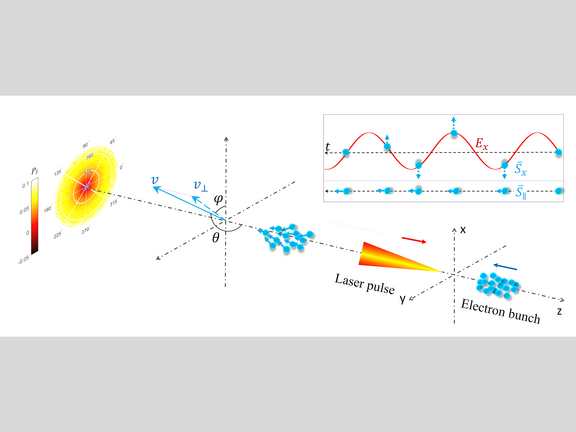High-precision high-energy physics at accelerators demands longitudinally spin-polarized electron beams, e.g., the Q-weak experiment at Jefferson Lab and E158 at SLAC. Presently, a common way of producing circularly polarized electrons in accelerators employs the old technique of the photoemission induced by a circular polarized laser field from a solid. There were a series of attempts to employ Compton scattering for this purpose. While here the helicity (direction of rotation with respect to the direction of propagation) of the laser photons is efficiently transferred to emitted gamma-rays, the longitudinal polarization of the scattered electrons is not efficient in the linear regime and suppressed in the nonlinear regime.
In strong background fields electrons can be polarized due to the spin-flip during photon emissions, which was first discovered for synchrotron radiation and termed as radiative polarization. Recently, the possibility has been proven of efficient radiative polarization using ultrastrong laser fields, applied to produce polarized electrons and positrons on a femtosecond timescale, as well as for polarization transfer from electrons to gamma rays in laser fields. In radiative polarization the electron spin flip is preferable along the instantaneous magnetic field in the rest frame of the electron. Because of that in ultrastrong laser fields initially unpolarized electrons are mostly polarized transversely after the interaction, while covet for high-energy physics is the longitudinal polarization.
In a recent collaboration with two previous group members and now professors in China, the role of the electrons’ anomalous magnetic moment on the helicity transfer from a circularly polarized (CP) laser pulse to an ultrarelativistic electron beam for the nonlinear Compton scattering process in the radiation reaction dominated regime is investigated. While previous studies neglecting the QED radiative corrections came to a conclusion that the helicity transfer from laser photons to electrons is forbidden in the nonlinear Compton scattering process, a sizable longitudinal polarization of electrons is obtained when the one-loop QED vertex correction to the anomalous contribution to the magnetic moment is accounted for. This scheme can directly produce substantial longitudinal electron polarization without any additional polarization rotator and in an orders of magnitude faster timescale.
The physical mechanism behind the applied scenario of the helicity transfer during nonlinear Compton scattering is clarified. Initially, spin flips during photon emissions induce electron transverse polarization which is phase matched with the laser field because of the spin-flip preference along the magnetic field. The phase-matched property of the transverse polarization and the anomalous correction to the magnetic moment leads to the transformation of the oscillating transverse polarization into accumulated longitudinal polarization during the interaction. The latter demonstrates a signature of QED radiative corrections for electron polarization dynamics in ultrastrong laser fields and challenges the belief that circularly polarized laser beams cannot induce high longitudinal polarization. Thanks to high collision luminosity in the nonlinear regime, this single-shot signature is robust with respect to the laser and electron parameters and measurable with currently available experimental strong-field laser technology and could also serve for testing QED predictions on radiative corrections.
Original publication:
Helicity Transfer in Strong Laser Fields via the Electron Anomalous Magnetic Moment
Y. Li, Y. Chen, K. Z. Hatsagortsyan, and C. H. Keitel
Phys. Rev. Lett. 128, 174801 (2022), DOI: 10.1103/PhysRevLett.128.1748011
Group Hatsagortsyan in the Division Keitel at MPIK
![[Translate to English:] [Translate to English:]](/mpi/fileadmin/_processed_/4/1/csm_Helicity_Abb-1_83722952b8.png)
